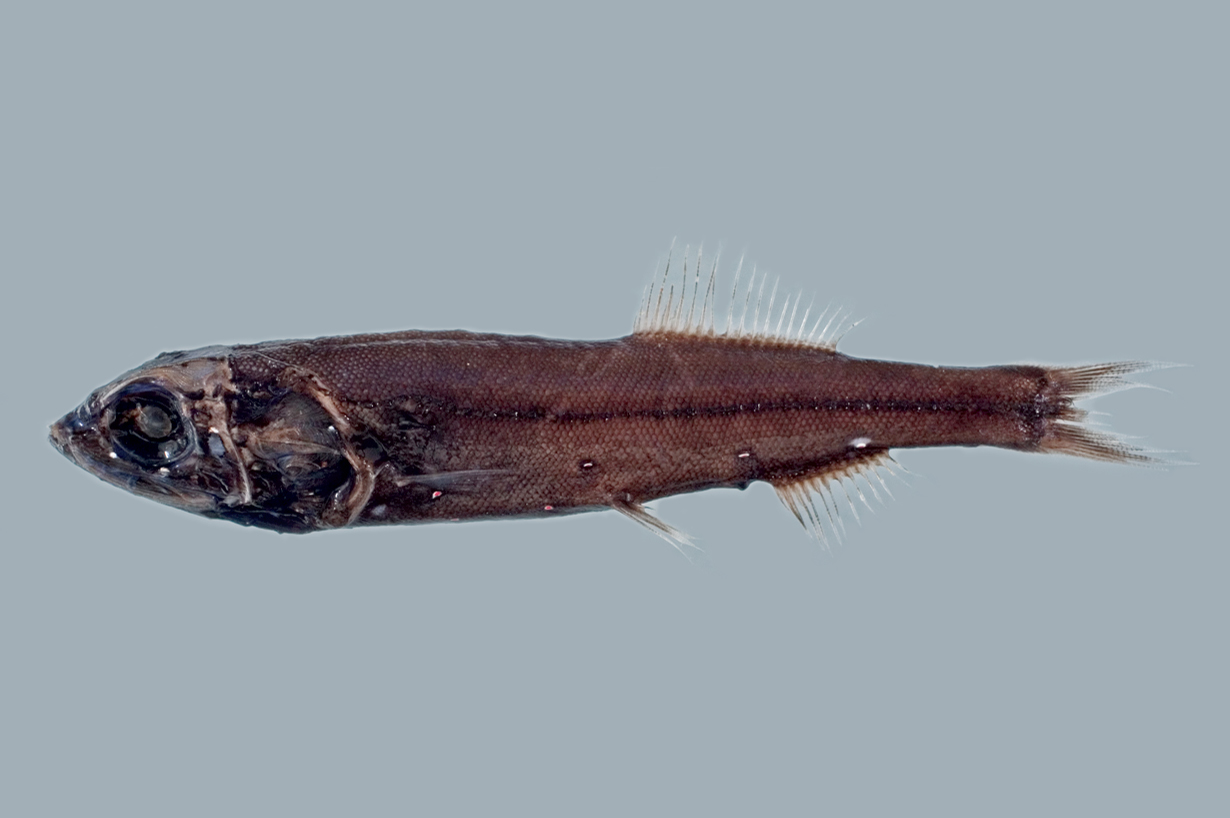Spangled Tubeshoulder, Persparsia kopua (Phillipps 1942)

A Spangled Tubeshoulder, Persparsia kopua, from south of Norfolk Island, between the surface and 1202 m in international waters south of Norfolk Island, June 2003 (NMNZ P.39532). Source: Kerryn Parkinson / NORFANZ founding parties. License: All rights reserved
Summary:
A tubeshoulder with relatively large, regular photophores on the head and lower parts of the body.
Cite this page as:
Bray, D.J. 2017, Persparsia kopua in Fishes of Australia, accessed 06 Jul 2025, https://fishesofaustralia.net.au/Home/species/1852
Spangled Tubeshoulder, Persparsia kopua (Phillipps 1942)
More Info
|
Distribution |
East of Newcastle, New South Wales, to SW of Point Culver, Western Australia, and around Tasmania; also Barcoo Seamount, Tasman Sea. Elsewhere the species is southern circumglobal in temperate waters (except South America). |
|
Biology |
All platytroctids have a postcleithral luminous gland that releases a luminescent secretion which presumably startles or blinds predators, allowing the fish to escape. |
|
Species Citation |
Bathytroctes kopua Phillipps 1942, Rec. Dominion Mus. 1(1): 49, pl. 16(1). Type locality: Cook Strait, New Zealand, depth 100 fathoms, stomach content. |
|
Author |
Bray, D.J. 2017 |
|
Resources |
Spangled Tubeshoulder, Persparsia kopua (Phillipps 1942)
References
Flynn, A.J. & Pogonoski, J.J. 2012. Guide to Mesopelagic Fishes of the Southern Tasman Sea. Hobart, Australia : CSIRO Marine and Atmospheric Research i-v + 221 pp.
Gomon, M.F. 1994. Family Platytroctidae. 245 fig. 219 in Gomon, M.F., Glover, C.J.M. & Kuiter, R.H. (eds). The Fishes of Australia's South Coast. Adelaide : State Printer 992 pp. 810 figs.
Matsui, T. & Rosenblatt, R.H. 1971. Ontogenetic changes in pattems of light organs in searsids and the taxonomy of Sagamichthys and Persparsia. Copeia 1971: 440-448.
Matsui, T. & Rosenblatt, R.H. 1986. Family No. 65: Platytroctidae. pp. 223-225 in Smith, M.M. & Heemstra, P.C. (eds). Smith's Sea Fishes. Johannesburg : Macmillan South Africa xx + 1047 pp. 144 pls.
Matsui, T. & Rosenblatt, R.H. 1987. Review of the deep-sea fish family Platytroctidae (Pisces: Salmoniformes). Bulletin of the Scripps Institution of Oceanography 26: 1-159
Parr, A.E. 1951. Preliminary revision of the Alepocephalidae, with the introduction of a new family, Searsidae. American Museum Novitates 1531: 1-21 (as Persparsia taaningi)
Parr, A.E. 1960. The fishes of the family Searsidae. Dana Reports 51: 1-109 figs 1-73
Phillipps, W.J. 1942. New records of bathypelagic fishes from Cook Strait. Records of the Dominion Museum 1(1): 49-54 figs 16-17
Sazonov, Yu.I. 1986: Morphology and classification of the fishes of the family Platytroctidae (Salmoniformes, Alepocephaloidei). Tr. Inst Okeanol. Akad. Nauk SSSR 121: 51-96. (in Russian with English summary)
Sazonov, Yu.I. 1996. Morphology and significance of the luminous organs in alepocephaloid fishes, pp. 151-163. In: Uiblein, F., Ott, J., Stachowitsch, M. (eds) Deep-sea and extreme shallow-water habitats: affinities and adaptations. Biosystematics and Ecology Series 11 PDF
Williams, A. & Sazonov, Y.I. 2008. Family Alepocephalidae and Platytroctidae. pp. 201-210 in Gomon, M.F., Bray, D.J. & Kuiter, R.H. (eds). Fishes of Australia's Southern Coast. Sydney : Reed New Holland 928 pp.
Williams, A. & Stewart, A.L. 2015. Family Platytroctidae. pp. 346-353 in Roberts, C.D., Stewart, A.L. & Struthers, C.D. The Fishes of New Zealand. Wellington : Te Papa Press Vol. 2 pp. 1-576. Y
Young, J.W., Lamb, T.D. & Bradford, R.W. 1996. Distribution and community structure of midwater fishes in relation to the subtropical convergence off eastern Tasmania, Australia.l. Marine Biology 126(4): 571-584



